

- #Mac network settings static ip mac os x#
- #Mac network settings static ip manual#
- #Mac network settings static ip plus#
- #Mac network settings static ip series#
This reduces the need to manually configure settings.

DHCP is a network protocol that uses a DHCP server to control the distribution of network parameters, such as IP addresses, allowing systems to automatically request these parameters.
#Mac network settings static ip series#
If you wish to configure redundant NICs on the same subnet, us e NIC teaming.īy default, Dynamic Host Configuration Protocol (DHCP) is enabled for your B Series Appliance. These switches drop all packets received from eth1 since this NIC does not have the default gateway and is not present in the static ARP table of the gateway. Some switches are configured with static ARP. When eth0 receives these packets from the switch destined for eth1, eth0 drops the packets. Switches configured with dynamic ARP send packets randomly to either eth0 (192.168.1.5) or eth1 (192.168.1.10), not both. Given this configuration, traffic from both NICs are sent to the default gateway (192.168.1.1) regardless of which NIC received traffic.

#Mac network settings static ip plus#
Click the Plus ( +) button under DNS Servers box.ī. Router - Enter the desired default gateway address. Subnet Mask - Enter the desired subnet mask.ĭ. IP Address - Enter the desired IP address.Ĭ.
#Mac network settings static ip manual#
Manual Configuration: Snow Leopard (10.6) and Leopard (10.5)
#Mac network settings static ip mac os x#
NOTE: Mac OS X is configured for a DHCP TCP/IP connection by default. This document describes how to manually configure the TCP/IP settings within Mac OS X. This is useful when the Mac computer needs to be remotely accessible, and NAT settings (such as port forwarding or DMZ) have been configured in the router. This will cause the IP address on the Mac computer to remain the same, and not change. This would include manually configuring the IP Address, Subnet Mask, Default Gateway, and DNS addresses. In some cases, the TCP/IP settings on the Macintosh machine may need to be manually configured for Internet access.


 0 kommentar(er)
0 kommentar(er)
